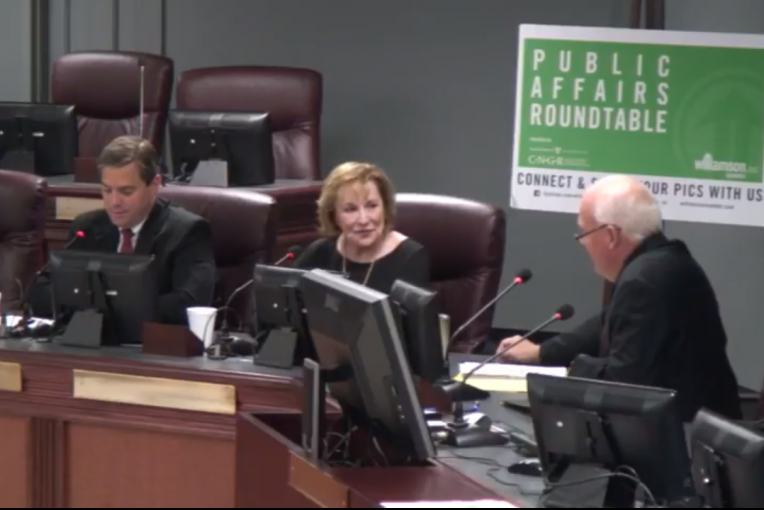Growth seems a constant in Williamson County, but Kirk Bednar, Brentwood city manager, says Brentwood is about 80 percent built out.
Regina Smithson, the mayor of Brentwood, and Bednar appeared and spoke at the monthly Public Affairs Roundtable hosted by Williamson, Inc, on Friday morning.
They discussed issues facing the city, and its trajectory- past, present and future. Two main subjects discussed were density of housing and commercial development.
First and foremost, Bednar said that whatever kind of development is coming, the peak is past.
“We are at the tail end of some big developments, such as the Hill Center, opening up beginning in October,” he said. “Unlike a lot of the communities here in Williamson County we don’t have that much more growth to come.”
“We are probably about 80 percent built out.”
With a population of 40,041 as of the latest U.S. Census, Bednar and Smithson foresee a maximum population of about 60,000 residents.
Those additional residents will live somewhere, but not in multi-family units.
Tapestry, the recently completed 393-unit condo complex at 400 Centerview Drive, was the only multi-family project approved in Brentwood in recent years, and likely the last as long as Smithson is mayor.
She said she would not approve or support anymore multi-family projects. Why?
“Because I went through Tapestry,” she said. “It was a different time period, it was a really down time for the economy, and we had merchants saying to us if we just had 10 more customers we wouldn’t go out of business. I wanted to help the seniors, and my children live in Brentwood, my grandchildren live in Brentwood- for them to be able to stay in Brentwood was attractive to me. I think it has worked out fine, but I would not approve any more.”
Bednar agreed, and pointed out that the city not only won’t but can’t approve any more mixed-use or multi-family projects.
“There is not at this point community support for those types of uses, but it has been taken out of our zoning so there really isn’t even an opportunity for multi-family projects at this point,” he said.
Most residential zoning in Brentwood limits density to no more than one unit per acre.
Dave Crouch, who was the moderator for the meeting, pointed out that the city of Franklin has adopted higher density because officials were afraid that without it the tax base would not support the infrastructure on a one-acre per house basis. How, then, do you do it with one-acre density, he asked?
“Well, we are really smart,” said Smith. “There are a lot of factors, the growth has been mostly steady. Brentwood is a city that the whole concept was to be residential in the center with commercial on each end, designated at a certain amount.”
She said the city staff has been very good with money, and intelligent with it.
“One thing we do is we don’t penalize departments for saving money,” she said. Referring to the habit of government to decrease a department’s budget in a year after not spending all their money, on the premise that if they didn’t spend it they don’t need it in the future.
“When you have good people working that are conscientious of the budget, and there are not underlying agendas that are self-serving, in my opinion, and I am very prejudiced, if every government could be run like Brentwood, we would all be in really good shape.”
Likewise, Bednar said that 55 percent of the city’s revenue comes from commercially zoned areas, which take up just 5 percent of Brentwood’s area.
The most visible current project is the Hill Center; Virginia Farms is another. The two commercial developments sit at either end of Maryland Farms.
“Upon completion, it pretty much builds out Maryland Farms- other than redevelopment,” Bednar said.
The plan going forward for Brentwood takes these issues into consideration. But it also follows public opinion.
Public opinion in Brentwood- surveys of public and business opinion undertaken in 2013- made it clear to the city that there was public concern, at least, about multi-family housing. Bednar said the results informed their current update of Brentwood 2020 plan, which will be most likely adopted as a 2025 or 2030 plan at the October 10 city commission meeting.
“Now we are at the point of producing the document,” said Bednar. “The end result is that the ultimate vision, goals and objectives of the community aren’t that different from 2020. Low density, residential community, historic preservation, green space preservation, are priorities.”



















